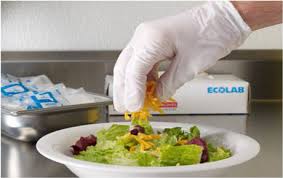Germs that cause food poisoning
Staphylococcus aureus
-Easily passed by dirty hand sneezes
Extra Information
It is frequently found as part of the normal
skin flora on the skin and nasal passages.
[1] It is estimated that 20% of the human population are long-term carriers of
S. aureus.
[1] S. aureus is the most common species of staphylococcus to cause
Staph infections.
S. aureus is a successful pathogen due to a combination of bacterial immuno-evasive strategies. One of these strategies is the production of
carotenoid pigment staphyloxanthin, which is responsible for the characteristic golden colour of
S. aureus colonies. This pigment acts as a
virulence factor, primarily by being a bacterial
antioxidant which helps the microbe evade the
reactive oxygen species which the host immune system uses to kill pathogens.
[2][3]
S. aureus can cause a range of illnesses, from minor skin
infections, such as
pimples,
impetigo,
boils (furuncles),
cellulitis folliculitis,
carbuncles,
scalded skin syndrome, and
abscesses, to life-threatening diseases such as
pneumonia,
meningitis,
osteomyelitis,
endocarditis,
toxic shock syndrome (TSS),
bacteremia, and
sepsis. Its incidence ranges from skin, soft tissue, respiratory, bone, joint, endovascular to
wound infections. It is still one of the five most common causes of
nosocomial infections and is often the cause of postsurgical wound infections. Each year, some 500,000 patients in American hospitals contract a staphylococcal infection.
[4]
Salmonella
-Grows in animals intestine

-Loves raw meat and poultry
Extra Information
Salmonella /ˌsælməˈnɛlə/ is a
genus of rod-shaped,
Gram-negative, non-spore-forming, predominantly
motile enterobacteria with diameters around 0.7 to 1.5
µm, lengths from 2 to 5 µm, and
flagella that grade in all directions (i.e.,
peritrichous). They are
chemoorganotrophs, obtaining their energy from oxidation and reduction reactions using organic sources, and are
facultative anaerobes. Most species produce
hydrogen sulfide,
[1] which can readily be detected by growing them on media containing
ferrous sulfate, such as
TSI. Most isolates exist in two phases: a motile phase I and a nonmotile phase II. Cultures that are nonmotile upon primary culture may be switched to the motile phase using a
Cragie tube.
[citation needed]
Escherichia coli
- Lives in the intestine of humans and animals
- Loves undercookedmeat
Extra Information
E. coli and related bacteria constitute about 0.1% of
gut flora,
[7] and
fecal-oral transmission is the major route through which pathogenic strains of the bacterium cause disease. Cells are able to survive outside the body for a limited amount of time, which makes them ideal
indicator organisms to test environmental samples for
fecal contamination.
[8][9] There is, however, a growing body of research that has examined environmentally persistent
E. coli which can survive for extended periods of time outside of the host.
[10]
Clostridium Perfrigens
- Found in food served in large portions

- Also found in food left in room temperature for a period of time
Below mentions how it causes food poisoning
In the United Kingdom and United States,
C. perfringens bacteria are the third most common cause of foodborne illness, with poorly prepared meat and poultry the main culprits in harboring the bacterium.
[2] The
clostridium perfringens enterotoxin (CPE) mediating the disease is heat-labile (inactivated at 74 °C) and can be detected in contaminated food, if not heated properly, and feces.
[6] Incubation time is between six and 24 (commonly 10-12) hours after ingestion of contaminated food. Often, meat is well prepared, but too far in advance of consumption. Since
C. perfringens forms spores that can withstand cooking temperatures, if let stand for long enough, germination ensues and infective bacterial colonies develop. Symptoms typically include abdominal cramping and
diarrhea; vomiting and fever are unusual. The whole course usually resolves within 24 hours. Very rare, fatal cases of
clostridial necrotizing enteritis (also known as pigbel) have been known to involve "Type C" strains of the organism, which produce a potently ulcerative
β-toxin. This strain is most frequently encountered in
Papua New Guinea.
Many cases of
C. perfringens food poisoning likely remain
subclinical, as
antibodies to the toxin are common among the population. This has led to the conclusion that most of the population has experienced food poisoning due to
C. perfringens.
[2]
Despite its potential dangers,
C. perfringens is used as the
leavening agent in
salt rising bread. The baking process is thought to reduce the bacterial contamination, precluding negative effects.
[3]
Source wikipedia.com
The above mentioned bacterias can cause very severe infection and we can easily contract it if we do not have the right way to handle food and practise good personal hygeine.
In order to prevent these germs from invading our bodies, me must
-Have good personal hygeine
-Buy the food safely
(Check for expiry date and other signs that the food has gone bad .
Such as dents in meatl container etc.... )
-Store the food safely
(If the food must be storedin a refrigerated place, do not leave it at room temperature. )
-Prepare the food safely
( Refer to steps below )
-Cook safely
( Make sure that you heat it until the germs die at the right temperature and do not overcook
ot there is no point of cooking the food. )
-Serving safely
(Even if you complete all the steps above correctly, there is no point if you do not serve properly at the last moment )
-Make sure that your hands are clean so that the germs do not "attack the food ".

( source of pictures : google.com )










